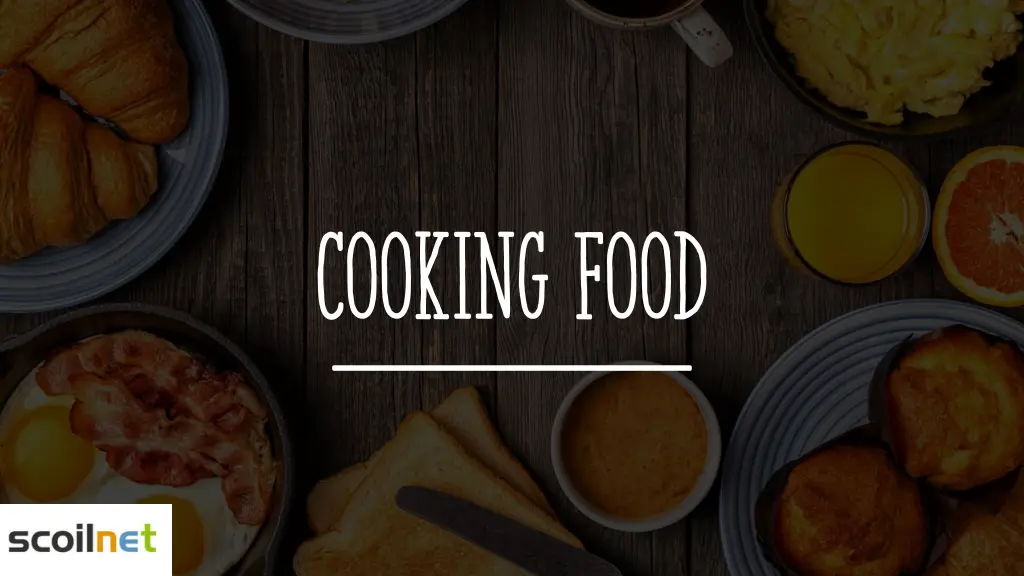
Explore the Art of Cooking: Methods, Effects, and Benefits
Enhance your culinary knowledge with insights into reasons for cooking food, the effects of cooking on different ingredients, methods of heat transfer, and the classification of cooking techniques. Discover how cooking kills bacteria, improves flavor, enhances appearance, aids digestion, and adds variety to your diet. Dive into the transformations that occur in eggs, meat, butter, and potatoes during the cooking process. Learn about conduction, convection, and radiation as methods of heat transfer, and classify cooking methods into moist and dry categories. Get ready to embark on a journey of sustainable and skillful cooking practices.
Download Presentation

Please find below an Image/Link to download the presentation.
The content on the website is provided AS IS for your information and personal use only. It may not be sold, licensed, or shared on other websites without obtaining consent from the author. If you encounter any issues during the download, it is possible that the publisher has removed the file from their server.
You are allowed to download the files provided on this website for personal or commercial use, subject to the condition that they are used lawfully. All files are the property of their respective owners.
The content on the website is provided AS IS for your information and personal use only. It may not be sold, licensed, or shared on other websites without obtaining consent from the author.
E N D
Presentation Transcript
What you will learn: Reasons for cooking food Effects of cooking on food Methods of heat transfer Classification of cooking methods Sustainable cooking
Reasons for cooking food For each reason give a suitable example: Kills bacteria Improves flavour of food Improves appearance of food Makes some food easier to digest Add variety to the diet
Effects of cooking on food: What happens to the following foods as they are cooking? What changes occur? Eggs Meat Butter Potatoes
Effects of cooking on food: Eggs Protein coagulates Colour change Meat Colour change Meat becomes tender Shrinks in size Butter Fat melts Potatoes Become softer
Methods of heat transfer:
Conduction: Heat travels from molecule to molecule along a solid object e.g. frying: heat moves from ring of cooker to frying pan to piece of food
Convection: When liquids and gases are heated, they rise. Cooler gases or liquids move in to replace them. This is called convection currents. e.g. when food is baked in the oven the hot air rises to the top of the oven
Radiation Hot rays from a heat source hit the surface of food and heat moves through it, cooking it. e.g. grilling food
Classify the following methods under the following headings: 1. Moist cooking methods: 2. Dry cooking methods: Classification of cooking methods: Boiling/simmering Baking Pressure cooking Roasting Stewing Steaming Grilling Barbequing Poaching
Carousel activity As you visit each station, fill in the section of the chart You will have 3-4 minutes per station 1. Boiling 2. Simmering 3. Poaching 4. Steaming 5. Stewing 6. Baking 7. Grilling 8. Barbequing 9. Roasting
Moist Cooking methods: Method: Boiling Simmering Poaching Steaming Stewing Definition: Advantages: Disadvantages: Suitable foods:
Dry Cooking methods: Method: Baking Grilling Roasting Definition: Advantages: Disadvantages Suitable foods
Frying Method: Definition: Suitable foods: Shallow frying Deep-fat frying Stir frying Dry frying
Safety when frying: Cooking with fat can be dangerous because it can go on fire Smoke point: a blue haze rises off the fat Flash point: the fat ignites (bursts into flames) If a frying pan goes on fire: Turn off the heat Place a lid/damp cloth/fire blanket over the flames Do not move the pan https:/
Microwave cooking Definition: Guidelines: Advantages: Disadvantages: Uses:
Standing time Leave food to stand for 2-3 minutes after removing from the microwave, during this time the food cooks further as the molecules are still vibrating
Revision of cooking methods Suggest a suitable cooking method for each of the following foods: 1. Eggs 2. Carrots 3. Bacon 4. Peas 5. Christmas pudding 6. Rhubarb 7. Whole chicken 8. Mushroom pie 9. Sausages 10. Battered cod
